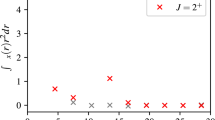Abstract
Coherent Tube Model predictions concerning secondary pion multiplicities and transverse momenta were compared with the experimental data. It was shown that the discrepancies between the model and our experimental data could not be removed by taking into account fragmentation processes.
Similar content being viewed by others
References
A.Kh. Abdurakhimov et al.: Nucl. Phys.A362, 376 (1981); V.D. Aksinenko et al.: Nucl. Phys.A 348 518 (1980)
S. Fredriksson: preprint TH.2423-CERN (1977)
Only negative pions are considered in experiments [1], since their samples are free from any contamination with secondary nucleons and nuclear fragments. Necessary corrections for an admixture of unidentified electrons were introduced
S. Fredriksson: Phys. Rev. Lett.45, 1371 (1980)
Y. Afek et al.: Phys. Rev. Lett.41, 849 (1978)
In our simple analysis the distributionsρ i of individual nucleons within the nuclear volume are assumed to be constant and not intercorrelated with the radius of nucleusR=r·A 1/3, wherer=1.27 fm
According to [5] the following formula forP(B) was used:P(B)=1−exp(−σ)∫d 2bT2(b)·T 1(B−b))
The following parametrization was taken for calculating the\(\tilde p\) Гr values:\(\tilde P_{T } (Q) = 235 + 69.5 \ln Q - 12.2(\ln Q)^2 MeV/c\)
S.A. Azimov et al.: Phys. Lett.73B, 339 (1978)
L. Bergström, S. Fredriksson: Phs. Lett.78B, 337 (1978)
J. Gosset et al.: Phys. Rev.16C, 629 (1977)
J. Hanlon et al.: Phys. Rev.19D, 49 (1979); A. Abdivaliev et al.: Nucl. Phys.B99, 445 (1975); NN and ND Interaction. — UCRL —2000 NN
The “universal” component of the multiplicity of π− mesons in the tube-tube collision includes the fragmentation of two protons which is the consequence of using ñ(Q) taken fromp−p data. The following calculation shows that taking into account proton fragmentation in the fragmentation part of formulae 5 does not changep Tf value. Average 〈p T〉 can be expressed as:\(\langle p_T \rangle = \frac{{n^u p_T^u + n^f p_T^f }}{{n^u + n^f }}\) wheren u is the number of “universal” pions,p Tu is the averagep T of the “universal” part (both taken from thepp data) andnv f, p fT are corresponding quantities for fragmentation part. After taking into account proton fragmentation we have:\(\langle p_T \rangle = \frac{{n^{u'} p_T^{u'} + n^{f'} p_T^{f'} }}{{n^{u'} + n^{f'} }}\) where\(\begin{gathered} n^{u'} = n^u - \Delta , n^{f'} = n^f + \Delta \hfill \\ n^{u'} p_T^{u'} = n^u p_T^u - \Delta p_T^{f'} \hfill \\ \end{gathered} \) Comparing these two expressions we get\(p_T^f = p_T^{f'} \) Exact calculation (i.e. based on the formulae (4) and (5)) gives the same result
Author information
Authors and Affiliations
Rights and permissions
About this article
Cite this article
Anikina, M.K., Gaździcki, M., Golokhvastov, A.I. et al. Test of the Coherent Tube Model approach to relativistic nucleus-nucleus interactions. Z. Phys. C - Particles and Fields 18, 109–111 (1983). https://doi.org/10.1007/BF01572470
Received:
Revised:
Issue Date:
DOI: https://doi.org/10.1007/BF01572470



